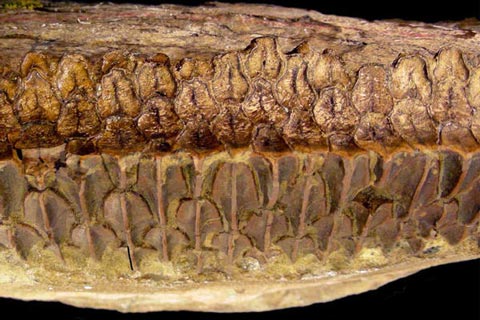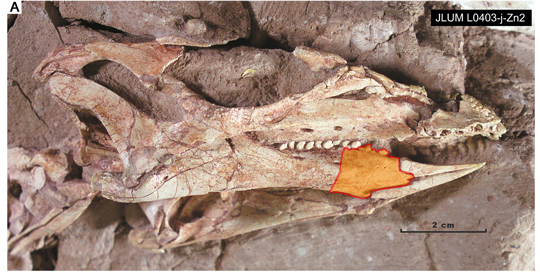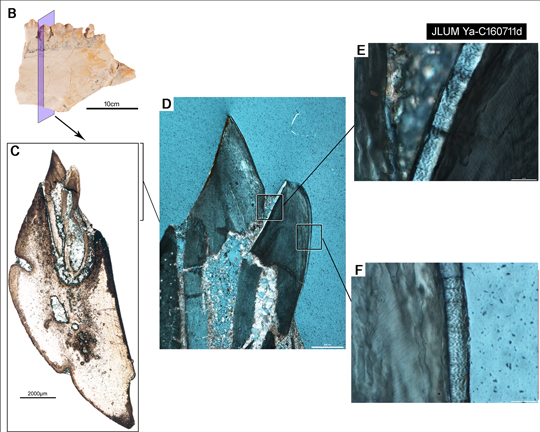Scientists Sink Their Teeth into Toothy Dinosaur Problem
Two of the most successful lineages of ornithischian dinosaurs are the ceratopsians (horned dinosaurs) and the hadrosaurs (duck-billed dinosaurs). These herbivores dominated the megafauna of many Late Cretaceous environments and one of the reasons for their success was their remarkable dental batteries. Although horned dinosaurs and duck-bills processed plant food in their mouths differently, (they had different chewing and grinding actions), the rows of teeth permitted these types of plant-eaters to process the toughest vegetation extremely efficiently
The Dental Battery of a Typical Hadrosaurid

Picture credit: Dr Gregory Erickson
However, the evolution of these dental batteries is poorly understood, so a team of Canadian and Chinese scientists set out to examine how this dentition may have come about. To do this they examined the teeth morphology and jaws of a little ornithopod from north-eastern China called Changchunsaurus parvus. This light-weight dinosaur that measured around 1.5 metres in length, is known from several skulls and other postcranial material from Jilin Province (China).
A Life Reconstruction of the Ornithopod Changchunsaurus (C. parvus)

Picture credit: Everything Dinosaur
How Did “Typical” Ornithischian Dentition Develop?
Writing in the academic, on-line journal “PeerJ”, the researchers from Jilin University and the University of Alberta, describe how thin slices were taken from five jaw bones of this dinosaur so that teeth in the jaw could be studied. In addition, the slices once polished to show their internal structure, would help the researchers determine tooth composition and to see how the teeth are maintained throughout the life of this little dinosaur. Changchunsaurus makes a good candidate for this type of work, as it is known from numerous skulls (albeit, some of them are quite distorted), and it is regarded taxonomically as being close to origins of the Ornithopoda.
One of the Skulls of Changchunsaurus parvus Used in the Study

Picture credit: Chen et al (PeerJ)
A Unique Method of Tooth Replacement
Among the notable features of Changchunsaurus parvus dentition is a unique method of tooth replacement that allowed this herbivore to recycle teeth without disrupting the continuous shearing surface formed by its tooth rows. This permitted Changchunsaurus to have an efficient tooth-grinding surface all the time, thus helping it to process tough plant material. The scientists also discovered that the teeth feature wavy enamel, a tissue type formerly thought to have evolved only in more derived members of the Ornithopoda. The wavy enamel of Changchunsaurus is the phylogenetically earliest occurrence of this type of tissue known.
A Section of Dentary (Lower Jaw) Sample Along with Cross-sections of Teeth Showing Morphology

Picture credit: Chen et al (PeerJ)
The picture above shows (B), an image of one of the partial lower jaws used in this research. The purple line shows the plane of sectioning. A whole view image of one of the thin sections through the lower jaw is shown (C) and (D) shows a magnified view of the process of tooth replacement. Images (E) and (F) show highly magnified views of identified wavy enamel on the crown of replacement teeth (labial and lingual margins).
Well-adapted to a Diet of Abrasive Plants
Commenting on the significance of this study, lead author Professor Chen Jun stated:
“These tissue-level details of the teeth of Changchunsaurus tell us that their teeth were well-adapted to their abrasive, plant-based diets. Most surprisingly, the wavy enamel described here, presumably to make it more resistant to wear, was previously thought to be exclusive to their giant descendants, the duckbilled dinosaurs.”
This research contradicts previous interpretations that this type of wavy enamel arose in association with more complex hadrosauroid dentitions. In view of its early appearance, the research team suggests that wavy enamel may have evolved in association with a shearing-type dentition in a roughly symmetrically-enamelled crown, although its precise function still remains somewhat of a mystery.
The authors suspect these features may have arisen early on in the Ornithopoda as they became adapted to herbivory, having to process tough vegetation.
The scientific paper:
“Tooth Development, Histology, and Enamel Microstructure in Changchunsaurus parvus: Implications for Dental Evolution in Ornithopod Dinosaurs” by Jun Chen , Aaron R. H. LeBlanc , Liyong Jin, Timothy Huang and Robert R. Reisz published in PeerJ.
Visit the Everything Dinosaur website: Everything Dinosaur.






Leave A Comment